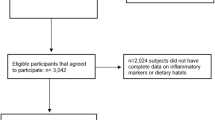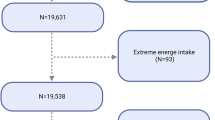Abstract
Background/Objectives:
Fiber-rich diets have been proposed to lower circulating levels of inflammatory makers. Our objective was to investigate cross-sectional relationships between fiber intake and plasma fibrinogen.
Subjects/Methods:
We examined the relationship between plasma fibrinogen and dietary fiber in 20 960 men and women, aged 45–75 years old, living in Norfolk, UK. Fiber intake was assessed using a food frequency questionnaire.
Results:
Mean fibrinogen levels were lower across the increasing quartiles of the fiber intake after adjusting for age, sex, body mass index, physical activity, smoking status and alcohol consumption, and total calories, percentage of energy intake from carbohydrate, protein and fat, with a difference of 0.08 g/l fibrinogen between first and fourth quartiles (P for trend <0.001) for the whole population. When categorized by sex, the results for men were the same and for women, the results failed to be significant. In linear regression models, fibrinogen levels were significantly related to fiber intake for the whole population (−0.056 g/l, s.e.=0.012 per 10 g increase in fiber intake, P<0.001), but although the relations were in the same direction after adjusting for the same covariates above, they failed to be significant when smokers or women not using post-menopause hormone therapy were separately considered.
Conclusions:
Plasma fibrinogen levels appear to be inversely related to dietary fiber intake in middle-aged and older men and women.
This is a preview of subscription content, access via your institution
Access options
Subscribe to this journal
Receive 12 print issues and online access
$259.00 per year
only $21.58 per issue
Buy this article
- Purchase on Springer Link
- Instant access to full article PDF
Prices may be subject to local taxes which are calculated during checkout
Similar content being viewed by others
References
Ajani UA, Ford ES, Mokdad AH (2004). Dietary fiber and C-reactive protein: findings from National Health and Nutrition Examination Survey data. J Nutr 134, 1181–1185.
Bengmark S (2004). Acute and ‘chronic’ phase reaction - a mother of disease. Clin Nutr 23, 1256–1266.
Berg AH, Scherer PE (2005). Adipose tissue, inflammation, and cardiovascular disease. Circ Res 96, 939–949.
Bingham SA, Welch AA, McTaggart A, Mulligan AA, Runswick SA, Luben R et al. (2001). Nutritional methods in the European Prospective Investigation of Cancer in Norfolk. Public Health Nutr 4, 847–858.
Bo M, Raspo S, Morra F, Cassader M, Isaia G, Poli L (2004). Body fat is the main predictor of fibrinogen levels in healthy non-obese men. Metabolism 53, 984–988.
Bo S, Durazzo M, Guidi S, Carello M, Sacerdote C, Silli B et al. (2006). Dietary magnesium and fiber intakes and inflammatory and metabolic indicators in middle-aged subjects from a population-based cohort. Am J Clin Nutr 84, 1062–1069.
Clauss A (1957). Rapid physiological coagulation method in determination of fibrinogen. Acta Haematol 17, 237–246.
Danesh J, Lewington S, Thompson SG, Lowe GD, Collins R, Kostis JB et al. (2005). Plasma fibrinogen level and the risk of major cardiovascular diseases and nonvascular mortality: an individual participant meta-analysis. JAMA 294, 1799–1809.
Esposito K, Marfella R, Ciotola M, Di PC, Giugliano F, Giugliano G et al. (2004). Effect of a mediterranean-style diet on endothelial dysfunction and markers of vascular inflammation in the metabolic syndrome: a randomized trial. JAMA 292, 1440–1446.
Folsom AR, Wu KK, Davis CE, Conlan MG, Sorlie PD, Szklo M (1991). Population correlates of plasma fibrinogen and factor VII. Putative cardiovascular risk factors. Artherosclerosis 91, 191–205.
Friedewald WT, Levy RI, Fredrickson DS (1972). Estimation of the concentration of low-density lipoprotein cholesterol in plasma, without use of the preparative ultracentrifuge. Clin Chem 18, 499–502.
Iacoviello L, Zito F, Di Castelnuovo A, De Maat M, Kluft C, Donati MB (1998). Contribution of factor VII, fibrinogen and fibrinolytic components to the risk of ischaemic cardiovascular disease: Their genetic determinants. Fibrinolysis Proteol 12, 259–276.
James S, Vorster HH, Venter CS, Kruger HS, Nell TA, Veldman FJ et al. (2000). Nutritional status influences plasma fibrinogen concentration: evidence from the THUSA survey. Thrombosis Res 98, 383–394.
Jensen MK, Koh-Banerjee P, Franz M, Sampson L, Grønbæk M, Rimm EB (2006). Whole grains, bran, and germ in relation to homocysteine and markers of glycemic control, lipids, and inflammation. Am J Clin Nutr 83, 275–283.
Karpanon EA, Vyssoulis GP, Toutouza MG, Georgoudi DG, Toutouzas PK (1992). Plasma fibrinogen changes in the menstrual cycle of hypertensive women. A multivariate approach. In: Ernst E, Koenig W, Lowe GDO, Meade TW (eds). Fibrinogen: A ‘New’ Cardiovascular Risk Factor. Blackwell-MZV: Vienna. pp 350–355.
Khaw KT, Bingham S, Welch A, Luben R, O’Brien E, Wareham N et al. (2004). Blood pressure and urinary sodium in men and women: the Norfolk Cohort of the European Prospective Investigation into Cancer (EPIC-Norfolk). Am J Clin Nutr 80, 1397–1403.
King DE, Egan BM, Geesey ME (2003). Relation of dietary fat and fiber to elevation of C-reactive protein. Am J Cardiol 92, 1335–1339.
King DE (2005). Dietary fiber, inflammation, and cardiovascular disease. Mol Nutr Food Res 49, 594–600.
King DE, Egan BM, Woolson RF, Mainous III AG, Al-Solaiman Y, Jesri A (2007). Effect of a high-fiber diet vs a fiber-supplemented diet on C-reactive protein level. Arch Intern Med 167, 502–506.
King DE, Mainous III AG, Egan BM, Woolson RF, Geesey ME (2008). Effect of psyllium fiber supplementation on C-reactive protein: the trial to reduce inflammatory markers (TRIM). Ann Fam Med 6, 100–106.
Lee AJ, Lowe GDO, Smith WCS, Tunstall-Pedoe H (1992). Plasma fibrinogen: Its relationship with oral contraception, the menopause, and hormone replacement therapy. Clin Biochem 25, 403–405.
Lowe GD (1992). Blood viscosity and cardiovascular disease. Thromb Haemost 67, 494–498.
Lowe GD (2005). Circulating inflammatory markers and risks of cardiovascular and non-cardiovascular disease. J Thromb Haemost 3, 1618–1627.
Ma Y, Hebert JR, Li W, Bertone-Johnson ER, Olendzki B, Pagoto SL et al. (2008). Association between dietary fiber and markers of systemic inflammation in the Women's Health Initiative Observational Study. Nutrition 24, 941–949.
Ma Y, Griffith JA, Chasan-Taber L, Olendzki BC, Jackson E, Stanek III EJ et al. (2006). Association between dietary fiber and serum C-reactive protein. Am J Clin Nutr 83, 760–766.
Masters RC, Liese AD, Haffner SM, Wagenknecht LE, Hanley AJ (2010). Whole and refined grain intakes are related to inflammatory protein concentrations in human plasma. J Nutr 140, 587–594.
Meade TW, Vickers MV, Thompson SG, Seghatchian MJ (1985a). The effect of physiological levels of fibrinogen on platelet aggregation. Thromb Res 38, 527–534.
Meade TW, Vickers MV, Thompson SG, Stirling Y, Haines AP, Miller GJ (1985b). Epidemiological characteristics of platelet aggregability. Br Med J (Clin Res Ed) 290, 428–432.
Meilahn EN, Kuller LH, Matthews KA, Kiss JE (1992). Hemostatic factors according to menopausal status and use of hormone replacement therapy. Ann Epidemiol 2, 445–455.
North C, Venter C, Jerling J (2009). The effects of dietary fibre on C-reactive protein, an iflammation marker predicting cardiovascular disease. Eur J Clin Nutr 63, 921–933.
Panagiotakos DB, Dimakopoulou K, Katsouyanni K, Bellander T, Grau M, Koenig W et al. (2009). Mediterranean diet and inflammatory response in myocardial infarction survivors. Int J Epidemiol 38, 856–866.
Pearson TA, Mensah GA, Alexander RW, Anderson JL, Cannon III RO, Criqui M et al. (2003). Markers of inflammation and cardiovascular disease: application to clinical and public health practice: A statement for healthcare professionals from the Centers for Disease Control and Prevention and the American Heart Association. Circulation 107, 499–511.
Pereira MA, O’Reilly E, Augustsson K, Fraser GE, Goldbourt U, Heitmann BL et al. (2004). Dietary fiber and risk of coronary heart disease: a pooled analysis of cohort studies. Arch Intern Med 164, 370–376.
The Fibrinogen Studies Collaboration (2007). Associations of plasma fibrinogen levels with established cardiovascular disease risk factors, inflammatory markers, and other characteristics: individual participant meta-analysis of 154,211 adults in 31 prospective studies: the fibrinogen studies collaboration. Am J Epidemiol 166, 867–879.
Van Horn L, McCoin M, Kris-Etherton PM, Burke F, Carson JA, Champagne CM et al. (2008). The evidence for dietary prevention and treatment of cardiovascular disease. J Am Diet Assoc 108, 287–331.
Voster HH (1999). Fibrinogen and women's health. Thrombosis Res 95, 137–154.
Wareham NJ, Jakes RW, Rennie KL, Schuit J, Mitchell J, Hennings S et al. (2003). Validity and repeatability of a simple index derived from the short physical activity questionnaire used in the European Prospective Investigation into Cancer and Nutrition (EPIC) study. Public Health Nutr 6, 407–413.
Weickert MO, Pfeiffer AFH (2008). Metabolic effects of dietary fiber consumption and prevention of diabetes. J Nutr 138, 439–442.
Welch AA, Luben R, Khaw KT, Bingham SA (2005). The CAFE computer program for nutritional analysis of the EPIC-Norfolk food frequency questionnaire and identification of extreme nutrient values. J Hum Nutr Diet 18, 99–116.
Welch AA, McTaggart A, Mulligan AA, Luben R, Walker N, Khaw KT et al. (2001). DINER (Data Into Nutrients for Epidemiological Research) - a new data-entry program for nutritional analysis in the EPIC-Norfolk cohort and the 7-day diary method. Public Health Nutr 4, 1253–1265.
Woodward M, Lowe GD, Rumley A, Tunstall-Pedoe H (1998). Fibrinogen as a risk factor for coronary heart disease and mortality in middle-aged men and women. The Scottish Heart Health Study. Eur Heart J 19, 55–62.
Yano K, Grove JS, Chen R, Rodriguez BL, Curb JD, Tracy RP (2001). Plasma fibrinogen as a predictor of total and cause-specific mortality in elderly Japanese-American men. Arterioscler Thromb Vasc Biol 21, 1065–1070.
Acknowledgements
To Professor Sheila A Rodwell (Bingham) who participated in conceiving and designing the research, but sadly passed away while this work was being prepared. This work was supported by program grants from the Medical Research Council, UK, Cancer Research UK and Conselho Nacional de Desenvolvimento Científico e Tecnológico-CNPq, Brazil (fellowship to RNF).
Author information
Authors and Affiliations
Corresponding author
Ethics declarations
Competing interests
The authors declare no conflict of interest.
Rights and permissions
About this article
Cite this article
Freitas, R., Luben, R., Wareham, N. et al. Relationship between plasma fibrinogen and fiber intake in the EPIC-Norfolk cohort. Eur J Clin Nutr 66, 443–451 (2012). https://doi.org/10.1038/ejcn.2011.194
Received:
Revised:
Accepted:
Published:
Issue Date:
DOI: https://doi.org/10.1038/ejcn.2011.194
Keywords
This article is cited by
-
A high intake of dietary fiber influences C-reactive protein and fibrinogen, but not glucose and lipid metabolism, in mildly hypercholesterolemic subjects
European Journal of Nutrition (2014)
-
Cardiovascular Benefits of Dietary Fiber
Current Atherosclerosis Reports (2012)



